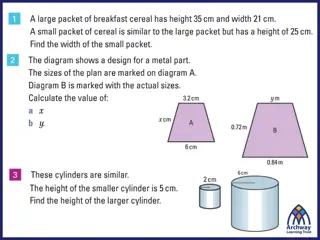Understanding Histogram Shapes and Distribution Patterns in Statistics
Explore the shapes of histograms and distribution patterns, including symmetric, skewed, bimodal, and uniform distributions. Learn to identify variables that are likely to be uniformly distributed, skewed right, skewed left, or symmetric in real-world data sets. Gain insights into key concepts like stem-and-leaf displays, summation notation, and measures of central location.
Uploaded on Oct 07, 2024 | 0 Views
Download Presentation

Please find below an Image/Link to download the presentation.
The content on the website is provided AS IS for your information and personal use only. It may not be sold, licensed, or shared on other websites without obtaining consent from the author. Download presentation by click this link. If you encounter any issues during the download, it is possible that the publisher has removed the file from their server.
E N D
Presentation Transcript
Statistics Session 4 Stem and Leaf Displays Summation Notation Measures of Central Location Ezra Halleck, City Tech (CUNY), Fall 2021
Review: important Shapes of Histograms 1. Symmetric (about the center) 2. Skewed (right or left) 3. Uniform or Rectangular 2
Symmetric Unimodal (bell-shaped) Bimodal (sum of 2 bells with different centers) Skewed: Left Right 3
A Histogram for a Uniform Distribution Theoretical; In practice The underlying distribution can be smooth, but a relatively small sample will appear jagged due to random variation. For a concrete example, roll a die 50 times, make a tally and then graph results. 4
Practice Which of these variables do you expect to be uniformly distributed? (a) heights of adult females (b) salaries of a random sample of people from North Carolina (c) house prices (d) birthdays of classmates (day of the month)
Practice Which of these variables do you expect to be uniformly distributed? (a) heights of adult females (b) salaries of a random sample of people from North Carolina (c) house prices (d) birthdays of classmates (day of the month)
Practice Which of these variables do you expect to be skewed right? (a) heights of adult females (b) salaries of a random sample of people from North Carolina (c) house prices (d) birthdays of classmates (day of the month)
Practice Which of these variables do you expect to be skewed right? (a) heights of adult females (b) salaries of a random sample of people from North Carolina (c) house prices (d) birthdays of classmates (day of the month)
Practice Which of these variables do you expect to symmetric? (a) heights of adult females (b) salaries of a random sample of people from North Carolina (c) house prices (d) birthdays of classmates (day of the month)
Practice Which of these variables do you expect to symmetric? (a) heights of adult females (b) salaries of a random sample of people from North Carolina (c) house prices (d) birthdays of classmates (day of the month)
2.3 Stem-and-Leaf Displays Definition In a stem-and-leaf display of quantitative data, each value is divided into two portions a stem and a leaf. The leaves for each stem are shown separately. 11
Example 2-8 The following are the scores of 30 college students on a statistics test: 75 69 83 52 72 84 80 81 77 96 61 64 65 76 71 79 86 87 71 79 72 87 68 92 93 50 57 95 92 98 Construct a stem-and-leaf display. 12
Example 2-8: Solution (1 of 2) To construct a stem-and-leaf display for these scores, we split each score into two parts. The first part contains the first digit, the stem. The second part contains the second digit, the leaf. Because all the scores lie in range 50 to 98, the stems are: 5, 6, 7, 8, and 9 . 13
Example 2-8: Solution (2 of 2) After we have listed the stems, we read the leaves for all scores and record them next to the corresponding stems on the right side of the vertical line: 15 To complete diagram, we optionally put each row of leaves in order.
Figure 2.17 Ranked Stem-and-Leaf Display of Test Scores One advantage of a stem-and-leaf display over a histogram is that we do not lose information on individual observations. We note that the sorting could have been done prior to separating the leaves from the stems. 16
Example 2-9 The following data give the monthly rents paid by a sample of 30 households selected from a small town. 880 1210 1151 1081 985 630 721 1231 1175 1075 932 932 1023 850 1100 775 825 1140 1235 1000 750 750 915 1140 965 1191 1370 960 1035 1280 Construct a stem-and-leaf display for these data. This is a step up in difficulty from the first example: the stems are from 6-13. 17
Example 2-9: Solution Figure 2.18 Stem-and-Leaf Display of Rents Optional step not shown is to put each row of leaves in order. 18
Example 2-10 The following stem-and-leaf display is prepared for the number of hours that 25 students spent working on computers during the last month. Exercise: Create a display with half the number of stems by joining categories. Use * to differentiate type of leaf within the new categories. 19
Example 2-11 Consider the stem-and-leaf display above. Use the split stem procedure, to provide finer detail. Would a 5 leaf appear in the top or bottom row for its stem? 20
1.7 Summation Notation Suppose a sample consists of five books, and the prices of these five books are $175, $80, $165, $97, and $88 The variable price of a book: x = = Price of the first book Price of the second book Price of the thrid book Price of the fourth book Price of the fifth book $175 = = = x 1 = $80 x 2 = $165 $97 $88 x 3 x = 4 = = x 5 21
Summation Notation Adding the prices of all five books gives + + + + = 175 80 165 97 88 + + + + = $605 x x x x x 1 2 3 4 5 = + + + + = $605 x x x x x x 1 2 3 4 5 22
Example 1-3 Annual salaries (in thousands of dollars) of four workers are 75, 90, 125, and 61, respectively. Find (b) ( x (a) x ) 2 2 (c) x 23
Example 1-3: Solution (1 of 2) (a) = = = + + + x x x x + x 1 2 3 4 + + 75 351 90 = 125 61 $351,000 (b) Note that( Thus, ) 2 is the square of the sum of all x values. x ( ) ( ) 2 2 = = 123,201 351 x 24
Example 1-3: Solution (2 of 2) (c) The expression is the sum of the squares of x we first square each of the 2 x values. To calculate x values and then sum these squared values. Thus, 2, x ( ) ( 5,625 8,100 15,625 3,721 + + 33,071 ) ( ) ( ) ( ) = + + + 2 75 90 125 61 x = = + 25
Example 1-4 The following table lists four pairs of m and f values: m f 12 5 15 9 20 10 30 16 Compute the following: (b) f mf (c) (a) m 2 2 m f (d) 26
Example 1-4: Hand Solution Here it is in a flash: = = = = = = = = 12 5 15 9 20 10 30 16 m f m f m f m f 1 2 3 4 1 2 3 4 Can anyone spot a typo? Next we show you how to do use Excel and Rguroo. 27
Doing table calculations with Excel m 12 15 20 30 =SUM(A2:A5) =SUM(B2:B5) =SUM(C2:C5) =SUM(D2:D5) =SUM(E2:E5) f 5 9 10 16 f^2 =B2^2 =B3^2 =B4^2 =B5^2 mf =A2*B2 =A3*B3 =A4*B4 =A5*B5 m^2 f =A2^2*B2 =A3^2*B3 =A4^2*B4 =A5^2*B5 sums m f 12 15 20 10 100 200 30 16 256 480 14400 77 40 462 875 21145 f^2 mf 25 81 135 m^2 f 5 9 60 720 2025 4000 The hidden formulas are shown in table above. Table below is live. Right click to open in Excel. Put in the formulas just in the first row, then fill down . 28
3.1 Measures of Center for Ungrouped Data Mean Median Mode Relationships among the Mean, Median, and Mode 29
3.1 Opening Example Do you know there can be a big difference in the starting salaries of college graduates with different majors? In 2013, engineering majors had an average starting salary of $62,600 business majors $55,100, math and science majors $43,000, humanities and social science majors $38,000 See Case Study 3 1 for more details. 30
Mean The mean for ungrouped data is obtained by dividing the sum of all values by the number of values in the data set. Thus, = x Mean for population data: N = x Mean for sample data: x n is the sum of all values; Where x N is the population size; n is the sample size; is the population mean; ? is the sample mean. 31
Table 3.1 2014 Profits of 10 U.S. Companies Company Apple AT&T Bank of America Exxon Mobil General Motors General Electric Hewlett-Packard Home Depot IBM Wal-Mart Profits (million of dollars) 37,037 18,249 11,431 32,580 5346 13,057 5113 5385 16,483 16,022 Find the mean of 2014 profits for these 10 companies (fortune.com). 32
Example 3-1: Solution x = + + + + + + + + + x x x x x x x x x x 1 2 3 4 5 6 7 8 9 10 = + + + + + 37,037 18,249 11,431 32,580 5,346 13,057 5,113 5,385 16,483 16,022 + + + + = 160,703 x 160,706 10 = = = = 16,070.3 $16,070.3million x n Thus, in 2014, these 10 companies earned an average of ~$16 billion profits. 33
Example 3-2 The following are the ages (in years) of all eight employees of a small company: 53 32 61 27 39 44 49 57 Find the mean age of these employees. The population mean is x 362 8 = = = 45.25 years N Thus, the mean age of the employees of this company is a little more than 45 years. 34
Example 3-3 Following are the list prices of eight homes randomly selected from all homes for sale in a city: $245,670 450,394 176,200 310,160 360,280 393,610 272,440 3,874,480 Note that the price of the last house is $3,874,480, which is an outlier. Show how the inclusion of this outlier affects the value of the mean. 35
Example 3-3: Solution (1 of 2) If we do not include the price of the most expensive house (the outlier), the mean of the prices of other 7 homes is: Mean without the outlier 245,670 176,200 360,280 + = + + + 470,394 310,160 393,610 + + 272,440 7 2,208,754 7 = = $315,536.29 36
Example 3-3: Solution (2 of 2) Now, to see the impact of the outlier on the value of the mean, we include the price of the most expensive home and find the mean price of eight homes. This mean is Mean with the outlier 245,670 176,200 360,280 + = + + + + + + 272,440 450,394 310,160 393,610 3,874,480 8 6,083,234 8 Thus, when we include the price of the most expensive home, the mean more than doubles, as it increases from $315,536.29 to $760,404.25. = = $760,404.25 37
Median (1 of 2) Definition The median is the value that divides a data set that has been ranked in increasing order in two equal halves. If the data set has an odd number of values o the median is given by the value of the middle term in the ranked data set; an even number of values o the median is given by the average of the two middle values in the ranked data set. 38
Table 3.2 Compensations of 11 Female CEOs 2014 Compensation (million of dollars) 19.3 16.2 19.6 19.3 33.7 21.0 22.5 16.9 28.7 42.1 22.2 Company & CEO General Dynamics, Phebe Novakovic GM, Mary Barra Hewlett-Packard, Meg Whitman IBM, Virginia Rometty Lockheed Martin, Marillyn Hewson Mondelez, Irene Rosenfeld PepsiCo, Indra Nooyi Sempra, Debra Reed TJX, Carol Meyrowitz Yahoo, Marissa Mayer Xerox, Ursula Burns Find the median of their compensation.. The compensation of Carol Meyrowitz of TJX is for the fiscal year ending in January 2015. 39
Example 3-4: Solution To calculate the median, we perform the following two steps. Step 1: We rank the given data in increasing order as follows: 16.2 16.9 19.3 19.3 19.6 21.0 22.2 22.5 28.7 33.7 42.1 Step 2: There are 11 data values. The 6th value divides these 11 values in 2 equal parts. Hence, the 6th value gives the median as shown below: Thus, the median of 2014 compensations for these 11 female CEOs is $21.0million. 40
Example 3-5 The following data give the cell phone minutes used last month by 12 randomly selected persons. 230 2053 160 397 263 3864 184 201 Find the median for these data. 510 326 380 721 Step 1: We put given data in increasing order: 160 184 201 230 263 326 380 397 510 721 2053 3864 Step 2: The division of the 12 data values in 2 equal parts falls between the 6th and 7th values. Step 3: median is the average of the 6th and 7th values. 41
Example 3-5 continued + 326 380 = Median = average of two middle values = minutes 353 2 Thus, the median cell phone minutes used last month by these 12 persons was 353. Notice the 2 outliers in this data set. The advantage of using the median as a measure of central tendency is that it is not influenced by outliers. Consequently, the median is preferred over the mean as a measure of center for data sets that contain outliers. 42
Mode The mode is the value that occurs with the highest frequency in a data set. The following data give the speeds (in miles per hour) of eight cars that were stopped on I-95 for speeding violations: 77 82 74 81 79 84 74 78 Find the mode. In this data set, 74 occurs twice and each of the remaining values occurs only once. Because 74 occurs with the highest frequency, it is the mode. Therefore, Mode = 74 miles per hour 43
Mode shortcoming and Uni, Bi and Multimodal A major shortcoming of the mode is that a data set may have none or more than one mode, whereas it will have only one mean and only one median. Unimodal: A data set with only one mode. Bimodal: A data set with two modes. Multimodal: A data set with more than two modes. 44
Example 3-9 (Data set with Three Modes) The ages of 10 randomly selected students from a class are 21, 19, 27, 22, 29, 19, 25, 21, 22 and 30 years, respectively. Find the mode. This data set has three modes: 19, 21 and 22. Each of these values occurs with a (highest) frequency 2. 45
Mode advantage One advantage of the mode is that it can be calculated for both kinds of data quantitative and qualitative, whereas the mean and median can be calculated for only quantitative data. Example: The status of five students who are members of the student senate at a college are senior, sophomore, senior, junior, and senior, respectively. Find the mode. Because senior occurs more frequently than the other categories, it is the mode for this data set. We cannot calculate the mean and median for this data set. 46
Trimmed Mean After we drop k% of the values from each end of a ranked Data set, the mean of the remaining values is called the k% trimmed mean. To calculate the trimmed mean first we rank the given data in increasing order. Then drop k% of the values from each end of the ranked data where k is any positive number, such as 5% or 10%. Find mean of the (100-2k)% remaining data. 47
Example 3-11 The data give the money spent (in dollars) on books during 2015 by 10 students selected from a small college. 890 1354 1861 1644 87 Calculate the trimmed mean. First we rank the given data: 5403 1429 1993 938 2176 87 890 938 1354 1429 1644 1861 1993 2176 5403 Calculate the 10% trimmed mean. 10% of 10 values Hence, we drop one value from each end of the ranked data. After we drop the two values, one from each end, we are left with the following eight values: ( ) = = 10 .10 1 890 938 1354 1429 1644 1861 1993 2176 48
Example 3-11 (cont) x = 890 938 1354 1429 1644 1861 1993 2176 12,285 + + + + + + + = 12,285 8 = = = 10% Trimmed Mean 1535.625 $1535.63 After dropping 10% of the values from each end of the ranked data for this example, we found that the remaining students spent an average of $1535.63 on books in 2015. In this data set, $87 and $5403 are outliers. So, to get a good sense of what most students averaged, we used the trimmed mean. 49
Weighted Mean (1 of 2) When different values of a data set occur with different frequencies, that is, each value of a data set is assigned different weight, then we calculate the weighted mean: 1. Denote the variable by x and the weights by w. 2. Add all the weights and denote this sum by w. 3. Multiply each value of x by the corresponding value of w. 4. The sum of the resulting products gives xw. 5. Dividing xw by w gives the weighted mean. = xw w Weighted Mean 50























